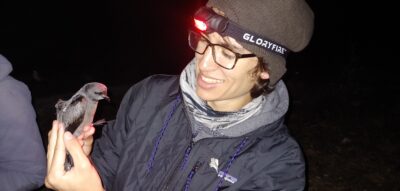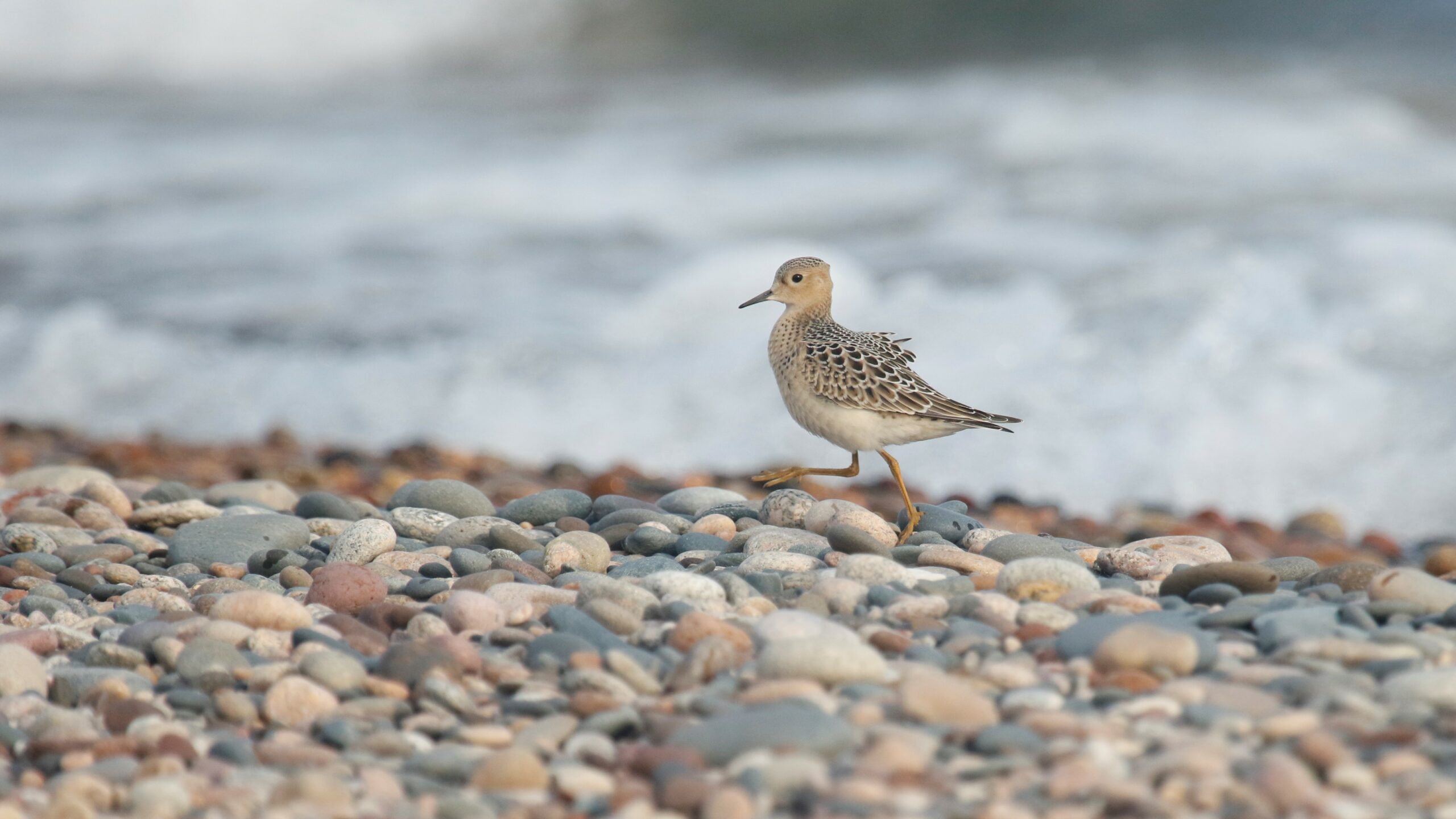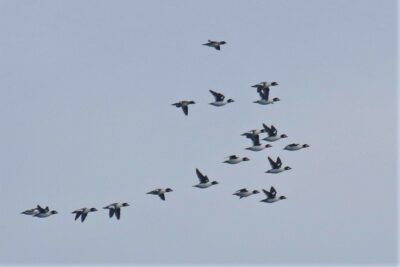Starting the fall of 2021 waterbird count at Whitefish Point Bird Observatory (WPBO), I felt similar to how many migration counters and researchers feel across the country — filled with excitement and eager anticipation for what will appear along the horizon. Certain conditions often challenge this mindset, but this fleeting doubt quickly subsides when the arrival of a bird appears on the scene. This fall count brought mild weather, which can be a double-edged sword by producing poor migration conditions.
Having now spent my first season in the Upper Peninsula, I feel honored to have contributed to the 32nd annual fall waterbird count. My background in studying birds primarily comes from California. There are apparent differences between these two regions, but one crucial similarity shared between both areas is the dedicated observers. During poor weather, I can shelter in the shack, but many birders endure the relentless rain and cold in the hope of experiencing something grand. Putting in the grind, combined with curiosity and passion for collecting this data, is a significant foundation that assists in the acts of management and conservation for wildlife.
As for being in the field, the first few weeks were the warmest, allowing for comfortable fieldwork at the waterbird shack. Dabbling ducks like the Blue-winged Teal and hundreds of Red-necked Grebes made the majority of early migration. In contrast, other early migrants consisted of 17 species of shorebirds, including post-breeding Piping Plovers and our only Red Knot of the season. Having the opportunity to observe the near-threatened Buff-breasted Sandpiper closely, an elegant Arctic breeder migrating to South America, was one of my top experiences this fall. Other early migrants consisted of several Caspian Terns, a single Black Tern, and the highest count of Common Terns for the season. Shortly after the significant movement of terns, our most anticipated sighting of a jaeger appeared between the swells.
Once we were in September, it was clear the full force of migration was in motion. Three days of this month broke over a thousand individuals, which provided peak migrations for Canada Geese, Gadwalls, Northern Shovelers, Sandhill Cranes, Black Terns, jaegers, and many of the shorebird species. For the month, our most notable waterbird sightings were a couple of Sabine’s Gulls, all three jaeger species, a pair of early Harlequin Ducks, and three separate Sora sightings. Another spectacular spectacle this fall was the mass existence of Pluvialis plovers (Black-bellied Plover and American Golden-Plover) on Sept. 5. Also, Sandhill Cranes made the highest count on record in a single day (Sept. 24). There were several memorable jaeger showings this year. My personal favorite was on Sept. 21 when Fall Field Ornithologist Chris Neri spotted a closer jaeger hazing a Herring Gull (one of the largest gulls on the scene). At first glance, it appeared to look like an adult Parasitic Jaeger by plumage (seen earlier in the day), but as it banked, the “spoons” on the rectrices were a dead giveaway that this was an adult Pomarine Jaeger in all its glory. The jaeger scene was a bit unreal, leading to the highest detection rate of any fall.
Most of October was dominated by waterfowl, but also encountered were large numbers of loons, our high count of Bonaparte’s Gulls, and Forster’s Terns. The first couple of weeks of October provided a fair movement of Red-throated and Common Loons. During our peak flight of Common Loons (Sept. 14), an immature Pacific Loon was spotted amongst a group of loons that formed the trifecta of expected loon species. Quickly following the mass appearance of loons were outstanding numbers of Aythaya, such as both scaup species, Redhead, Ring-necked Duck, and a single Canvasback. The week of Sept. 15–21 was also peak flight for American Wigeon, Mallards, American Black Ducks, all three scoters, Long-tailed Ducks, and Red-breasted Mergansers. We saw many of our final appearances of shorebirds during early October, but later migrants such as White-rumped Sandpiper and Dunlin flocks were encountered. We even had an unexpected detection, then later appearance, of an American Woodcock winnowing over the treeline. The final week of October brought some often underappreciated activity of gulls to the Point. There were multiple sightings of juvenile Black-legged Kittiwakes, typically known as a pelagic species, while a Lesser Black-backed Gull and an Iceland Gull were seen near the harbor.
November was kind to this California kid, which allowed us to peel a few layers to bask in the patchy sun before the next frost. After drinking a tall glass of iced tea (just kidding, it was still too cold for that nonsense), we encountered the peak flight for Bufflehead, Common Goldeneye, and Hooded Mergansers. One of the most notable waterbirds spotted this month was a Red Phalarope dodging between waves exceeding three feet in height, practicing its vigilance before having to cross the open ocean where it will spend most of its winter.
At the end of it all, the number of waterbirds counted was 93,515 individuals, which is above the average since 1989 but less than the last decade’s average by 5.8%. These totals are arbitrary and should be broken down to lower taxa levels (order, family, genus, species) before coming to any conclusions. For example, waterfowl alone (geese, swans, and ducks) made ~70% of the total waterbirds counted this season. Of the total waterbirds, diving ducks made ~59% (~80% of the total waterfowl), but it should be noted that Long-tailed Ducks alone made ~26% of the total waterbirds counted. Long-tailed Ducks this season are above the cumulative average since 1989 but below average within the past decade by 4%. These trends are a rudimentary breakdown of what we report each season, but there are 32 years of census data available for a more comprehensive analysis. Moving forward, I will provide general trends and highlights for specific groups.
Of the 81 waterbird species, several were documented with record-breaking highest abundance for the count: Wood Duck, Mallard, Northern Pintail, Hooded Merganser, Sandhill Crane, Black-bellied Plover, Solitary Sandpiper, Lesser Yellowlegs, Least Sandpiper, and Wilson’s Snipe. Others faced some of the lowest on record, the most notable being Red-necked Grebe and Canada Goose. But, based on eBird data and local speculation, Red-necked Grebe peak migration may have occurred before the fall count.
While our primary focus is to count waterbirds, we record every bird species detected, bringing our season total to 119,430 individuals and 211 species. The general trend of landbird migration was that early-season had an influx of warblers and diurnal raptors. Mid-season brought a mini fallout of sparrows and concluded with a bountiful count of finches. Notable sightings this season were a Black Vulture on Sept. 1, a Western Kingbird in mid-September, a couple of Townsend’s Solitaires late in the season, and a LeConte’s Sparrow skulking along the dune grass on Oct. 1. Probably the most memorable bird of the season was the Sprague’s Pipit. This bird evaded us for a day before a group double-downed and paraded around the Point to eventually produce some stunning photos of the species. This represents the sixth state record, third count record, and first record since 1995!
The sightings at WPBO this fall are some of the most joyous memories I have experienced: hearing the flight calls of Sprague’s Pipit, experiencing the mass flight of jaegers, sifting through the gull flocks, watching thousands of finches overhead. At times it was difficult to comprehend the volume of birds moving within the day. In my eyes, any form of migration, whether it be invertebrate, mammal, or fish, is considered the highest tier of the world’s natural wonders.
I want to give a special shoutout to Adam Byrne, Alec Olivier, Leonard Graf, Rhoda Johnson, and Tim Baerwald for covering the count this season. Of course, I can’t give thanks enough to Chris Neri and Nova Mackentley for keeping my spirits high throughout the season. I’m glad winter didn’t arrive until after I left.
~ by Mario Balitbit, 2021 Whitefish Point Bird Observatory fall waterbird counter
Featured photo: Buff-breasted Sandpiper by Mario Balitbit

Mario discovered his love for birds at an early age while volunteering in wildlife rehabilitation and birding across California. His drive to understand the avian world has opened opportunities to share with others through environmental education, touring, and photography. During these early experiences, he completed his B.S. at Humboldt State University as a wildlife and conservation management major. Now he is a wildlife biologist, moving where the birds and opportunities take him. You can find Mario partaking in long-term bird projects such as bird banding, pelagic leading, and other avian-related work.
This article appeared in the 2022 Winter Jack Pine Warbler.


